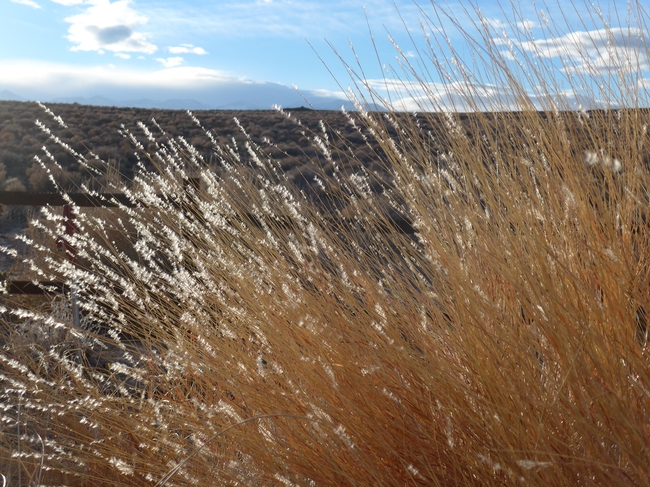I don't know if it's an American thing or a universal trait, but we all seem to love an underdog, and I've always had a special place in my heart for the perennially underappreciated ornamental grasses. Like Rodney Dangerfield, they just don't get the respect they deserve!
Every day of the winter I am reminded that these stalwart members provide much of the interest in my garden during the offseason. In our climate, nearly nothing besides conifers stays green year round. Many bushes that retain their leaves in milder climes lose them in the Eastern Sierra. Though these skeletons can have their own subdued appeal, a landscape of endless gray is not terribly exciting. Dried grasses provide touches of yellow, orange, and even red to an otherwise drab winter landscape. The setting sun sparkles through their golden inflorescences, and nothing is quite as beautiful as a new carpet of snow lying at their feet.
They provide a unique vertical element in the garden. A mass planting of grasses makes a great backdrop for flowers and other forbs in the warmer season. Their green luxuriance is the very essence of summer. And they come in all sizes, so there's a place for ornamental grasses in any garden area.
Grasses provide more year-round interest in the garden than anything else I can think of, and yet they are relatively carefree. When most people think of grass, they picture a lawn. What could require more work than turf grass? Endless hours of watering, fertilizing, and mowing. Ugh! But unlike their thirsty cousins, many ornamental grasses are relatively xeric, and during the growing season all you have to do is give them a bit of water, step back and let ‘em grow. And grow they do, once things heat up! We all know about the prodigious growth rate of bamboo, like the rest of the grasses, a member of the family Poacaeae.
The only downside to ornamental grasses is their very considerable upside—they can be too successful! Most ornamental grasses grow in clumps, from the inside out, so the centers tend to die off after a few years. By digging them up and dividing them, you are rejuvenating the plant. Give your grasses a “hair cut” once new growth begins in the spring. Every few years, dig up the plants, divide them, discard the dead bits, and you'll have dozens of new grasses to plant or share with friends. With smaller grasses like Festuca glauca (blue fescue), this is a relatively minor task.
On the other hand, dividing something like Miscanthus sinensis is not for the faint of heart, and special tools may be required. Just getting the root ball out of the ground may be a two-person job! After many years of backbreaking work, I've found that the best way to divide these monsters is with a reciprocating saw (sometimes called a Sawzall). I bought a corded one last year for less than $50 and it was a lifesaver. If you already have a chain saw, you could even use that! Here's a video that illustrates how power tools can be used to transform a previously impenetrable mass of roots into dozens of healthy new plants.
Next time we'll cover some of the best ornamental grasses for the Eastern Sierra. Stay tuned!
